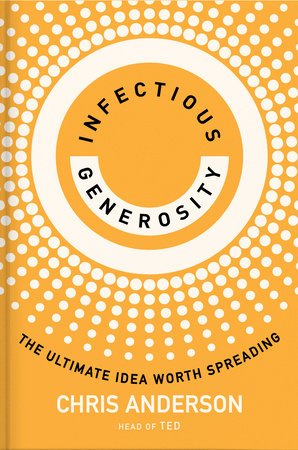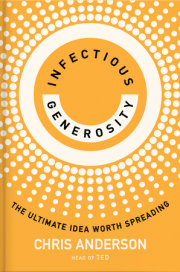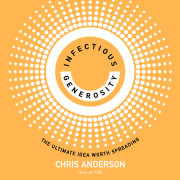1
Inside a ContagionThe surprising aftermath of a decision to give
Let me share with you the experience that opened my eyes to the Internet’s potential to turbocharge generosity.
I’m a media entrepreneur. For the first half of my career, I built a company in the UK and the US that published scores of hobbyist magazines, many of them about technology. In 1998 I was invited to attend a conference in California that, unusually, was devoted not to one industry but to three: technology, entertainment, and design. Yup, this was the TED conference.
Because of the conference’s breadth of content, speakers had to make their work accessible to outsiders, and it turns out that when you do that, there is a crossover effect. Software creators were inspired by physical architecture, screenwriters and artists had their minds blown by technologists, and everyone felt the potential and significance of their work to be elevated. I was mesmerized.
A couple of years later, I had the opportunity to take over the conference from its charismatic co-founder. I leaped at the chance—partly because there seemed to be good prospects of expanding its sphere. It wasn’t just technology, entertainment, and design that could cross-pollinate with one another; it was every subject. All human knowledge is part of a single elusive reality. We don’t fully understand anything until we understand how it connects to the other parts of knowledge.
I couldn’t afford to buy TED personally—the dot-com bust of 2000–2001 had ravaged my media company, Future plc. So, instead, TED became part of a not-for-profit foundation I had created a few years earlier, when times were good. And I left Future to focus full-time on this weird conference and to ponder how it might grow.
Since it was now a nonprofit, TED had to be run for the public good. And that meant trying to find a way to gain a wider audience for the inspirational talks that were given there. In the early aughts, this was harder than you may think.
We tried to persuade TV networks that TED Talks would make for excellent viewing. They laughed at us. Public lectures were about the most boring thing they could imagine. Then we had a more radical idea.
The ExperimentOn the Internet, bandwidth was relentlessly increasing, and the fledgling technology of online video was starting to become viable. Back in 2006, it was often limited to a small low-res window in the corner of a desktop screen, but we felt it was worth a try. In an experiment, we posted six of the talks in full on our website.
To our surprise, they went viral, rapidly notching up tens of thousands of views. Not much by today’s standards, but for a website that had been getting just a few hundred visitors a day, it was startling. And the feedback we received from viewers shocked us in its intensity. People didn’t just like what they had seen. They loved it. They’d been inspired. And suddenly we were faced with a dilemma. As a nonprofit, we felt we had an obligation to freely share all of our best content online.
Now, this was clearly a dangerous move. Our attendees paid a lot of money to come to TED. That was by far the main source of income we had. Why would they continue to do that if the content was freely available on the Internet?
We weren’t sure. But we went ahead anyway.
The ResponseWhat happened next was astonishing.
First, the bulk of our conference-going community quickly got behind the move. A small handful grumbled, but the vast majority were thrilled that they could now share a profound experience with others.
And the response from those viewing these talks for the first time online was even more surprising. We were deluged with messages from people expressing how deeply they’d been moved, and how they wanted to help support the speakers and further help spread their ideas.
Visits to our website exploded into the millions, and TED was transformed from a niche conference to a global brand—all via word of mouth. Instead of demand for our conference being destroyed, it increased.
And something else happened: From all over the world we started receiving offers to translate the talks into local languages. Once we’d set up a system to facilitate this, literally thousands of volunteer translators got to work, collaborating in pairs so that they could verify each other’s work. Seventeen years later, TED Talks have been translated into more than one hundred languages by some fifty thousand generous souls.
What the Internet Taught UsThis was a lot to take in. We had made the decision to give away our talks mostly out of a sense of obligation—our nonprofit’s mission was to share valuable knowledge freely with the world. But what we got back was transformative. The Internet had spread TED Talks far and wide, generating millions, and then billions, of online views, attracting significant sponsorship revenue. Over the next three years, TED’s income multiplied more than tenfold, allowing us to ponder exciting new possibilities.
To shape those possibilities, a guiding principle came into focus. Back then, we called it radical openness. But today I think of it simply as, yes, infectious generosity. The Internet had taught us that if you gave away the biggest thing you could think of, you would be amazed at what came back.
So we asked ourselves:
Beyond our content, what else could we give away?First we founded a fellows program to bring to TED a global group of extraordinary thinkers and doers who couldn’t otherwise afford to come. This program rapidly became worth its weight in gold when an early fellow, Logan Smalley, an educator, approached us with the idea of launching a series of short animated videos to share knowledge and spark curiosity in learners of all ages. His TED-Ed program was itself powered by generosity. Teachers and animators gave their services for free or at reduced costs, and visionary donors covered the rest of the cost. Since 2011, Logan’s team has ended up creating more than fifteen hundred animations, many of which have won awards and are now used in tens of thousands of schools, and millions of homes, creating more than a billion sparks of curiosity every year.
The TEDx SurpriseBut undoubtedly the biggest risk we took was to give away our brand. The TED name itself. Lots of people had been inquiring about the possibility of having a TED conference in their own city. We couldn’t imagine how to do this. So we decided to let them do it themselves. We issued free licenses to organizers around the world. They could call it a TED event and thereby make it far easier to recruit both speakers and audiences. We just added a little asterisk to the brand in the form of an x. TEDx was intended to mean TED self-organized in location x, but the deeper meaning of the x turned out to be TED multiplied or even TED turned exponential.
Instead of TED being just a single annual event, there were suddenly hundreds, and then thousands, of events. Each event was put on by a local team who volunteered prodigious amounts of time and talent. They brought TED to movie theaters, universities, sports stadiums, opera houses, parliaments—as well as places we could never have imagined: rainforests, prisons, refugee camps. We had given away our brand, but to us, the generosity of the response seemed far more astonishing.
To many business advisers at the time, all this seemed crazy. Harvard Business Review even published an article on it, provocatively titled “When TED Lost Control of Its Crowd.” But the “loss” was deliberate. Yes, there were occasions when events bombed or an inadequately prepared speaker created embarrassment. But these were surprisingly rare. And over time the whole system improved. Local organizers gained invaluable experience and shared what they were learning with us and with one another.
TEDx brought remarkable voices to the world that we would probably never have discovered ourselves. Some of the most popular TED speakers of all time—including Brené Brown and Simon Sinek—were discovered at TEDx events.
And as I write, some fifteen years later, the decision to give away our brand seems like the wisest thing we could ever have done. More than twenty-five thousand TEDx events have been held. They’ve created an online archive of more than two hundred thousand talks. And those talks attract more than a billion views annually. A central team of just twelve people oversees the whole operation, offering guidance and training, and upholding adherence to our mission.
Using a traditional command-and-control structure, you could never build an events organization of anything like this scale with just twelve people. This is an operation made possible only because of the magic of infectious generosity. We gave away our brand and our advice. And what we got back was a worldwide knowledge-spreading miracle.
Copyright © 2024 by Chris Anderson. All rights reserved. No part of this excerpt may be reproduced or reprinted without permission in writing from the publisher.










